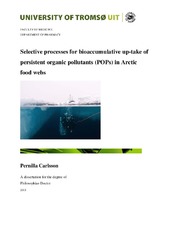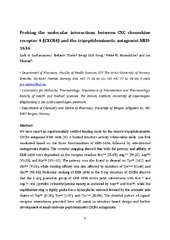Selective processes for bioaccumulative up-take of persistent organic pollutants (POPs) in Arctic food webs
Permanent lenke
https://hdl.handle.net/10037/5651Dato
2013-11-21Type
Doctoral thesisDoktorgradsavhandling
Forfatter
Carlsson, Pernilla MarianneSammendrag
The overall aim of the present study was to elucidate selective environmental up-take processes in Arctic food webs that lead to the bioaccumulation of persistent organic pollutants (POP) in food items consumed by Arctic indigenous people. In addition, this study aimed to increase the scientific understanding of the principles behind climate change related influences on transport processes of contaminants. Svalbard and Nuuk, Greenland were chosen as study areas since they represent Arctic conditions, e.g. glaciers, different marine water masses, long-range transport of POPs and few local sources of POPs. In addition, Greenland has a large population of indigenous people consuming traditional food on a daily basis.
This thesis is based on field campaigns and empirical data. Legacy pesticides were analysed in water samples from a Greenlandic fjord (paper I). The pesticide distribution indicated that glaciers and snow caps around the fjord are secondary sources of contaminants for the coastal marine environment. Chlordanes were identified as potential indicator compounds for meltwater runoff (paper I).
α-hexachlorocyclohexane (α-HCH), trans-, cis- and oxychlordane were chosen for enantiomer selective analyses in zooplankton from Svalbard and Greenlandic traditional food items (paper II, III). The enantiomeric fraction (EF) of α-HCH in the zooplankton was associated to ice cover/break-up. EFs of cis-chlordane were reflected in the deviation from racemic EF among oxychlordane. Chiral pesticides and enantiomer selective analyses are recommended for further studies regarding their potential as marker for changes of the physical environment (paper II).
Non-racemic EFs were detected for almost all food samples. Hence, species specific distribution exists, and can be an important factor in future dietary advices. Levels of polychlorinated biphenyls (PCB), polybrominated diphenyl ethers (PBDE), perfluorinated alkylated substances (PFAS) and pesticides were below tolerable daily intake threshold in the food items (paper III, IV). PFAS was detected in the marine mammals, but not in the fish samples, most likely due to industrial processing of the fish (paper IV).
Beskrivelse
The papers of this thesis are not available in Munin:
1. Carlsson P., Cornelissen G., Bøggild C.E., Rysgaard S., Mortensen J., Kallenborn R.: 'Hydrology-linked spatial distribution of pesticides in a fjord system in Greenland', Journal of Environmental Monitoring (2012), vol. 14:1437-1443. Available at http://dx.doi.org/10.1039/c2em30068k
2. Carlsson, P., Warner, N.A., Hallanger, I.G., Herzke, D., Kallenborn, R.: 'Spatial and temporal investigation of enantiomeric fractions for pesticides in Calanus spp. in three Arctic fjords' (manuscript).
3. Carlsson, P., Herzke, D., Kallenborn, R.: 'Enantiomer selective and quantitative trace analysis of selected persistent organic pollutants (POP) in traditional food from western Greenland' (manuscript).
4. Carlsson, P., Herzke, D., Kallenborn, R.: 'Polychlorinated biphenyls (PCBs), polybrominated diphenyl ethers (PBDEs) and perfluorinated alkylated substances (PFASs) in traditional sea-food items from western Greenland' (manuscript)
1. Carlsson P., Cornelissen G., Bøggild C.E., Rysgaard S., Mortensen J., Kallenborn R.: 'Hydrology-linked spatial distribution of pesticides in a fjord system in Greenland', Journal of Environmental Monitoring (2012), vol. 14:1437-1443. Available at http://dx.doi.org/10.1039/c2em30068k
2. Carlsson, P., Warner, N.A., Hallanger, I.G., Herzke, D., Kallenborn, R.: 'Spatial and temporal investigation of enantiomeric fractions for pesticides in Calanus spp. in three Arctic fjords' (manuscript).
3. Carlsson, P., Herzke, D., Kallenborn, R.: 'Enantiomer selective and quantitative trace analysis of selected persistent organic pollutants (POP) in traditional food from western Greenland' (manuscript).
4. Carlsson, P., Herzke, D., Kallenborn, R.: 'Polychlorinated biphenyls (PCBs), polybrominated diphenyl ethers (PBDEs) and perfluorinated alkylated substances (PFASs) in traditional sea-food items from western Greenland' (manuscript)
Forlag
UiT Norges arktiske universitetUiT The Arctic University of Norway
Metadata
Vis full innførselSamlinger
Copyright 2013 The Author(s)
Følgende lisensfil er knyttet til denne innførselen:
Med mindre det står noe annet, er denne innførselens lisens beskrevet som Attribution-NonCommercial-ShareAlike 3.0 Unported (CC BY-NC-SA 3.0)
Relaterte innførsler
Viser innførsler relatert til tittel, forfatter og emneord.
-
A Biofocussed Chemoprospecting Approach to Drug Discovery: Design, Synthesis and Bioactivity Screening of Diverse Biofocussed Chemical Libraries
Thakkar, Balmukund (Doctoral thesis; Doktorgradsavhandling, 2017-04-28)With pharma R & D witnessing rising cost, high attrition rates and an overall decline in productivity in recent times, newer approaches are needed for more efficient early phase drug discovery. This thesis describes a new approach, “biofocussed chemoprospecting”. The essence of the approach is to use diverse, yet “bio-like” compounds for efficient hit-finding, along with property filtering and ... -
Novel [18F]fluorinated prosthetic groups for the labelling of peptides for positron emission tyomography (PET)
Olberg, Dag Erlend (Doctoral thesis; Doktorgradsavhandling, 2009-11-20)Positron emission tomography is a non-invasive imaging modality allowing visualization and quantification of a wide variety of physiological and biochemical processes or of a specific lowdensity protein target. Some examples are blood flow, glucose consumption, fatty acid metabolism or detection and quantification of cell surface receptors in particular tissues. Within the spectrum of available ... -
Toward Tripeptidomimetic CXCR4 Antagonists: Design, Synthesis, Biological Evaluation, and Binding Mode Studies
Zachariassen, Zack George (Doctoral thesis; Doktorgradsavhandling, 2014-04-11)In order for the HIV virus to take over and destroy human immune cells, which results in AIDS, the virus first has to enter the cells. This takes place by interactions between viral proteins and specific receptors on the surface of our cells. One of these receptors is CXCR4, and it has been shown that chemical compounds that bind to and block the CXCR4 receptor, so-called CXCR4 antagonists, are able ...


 English
English norsk
norsk



